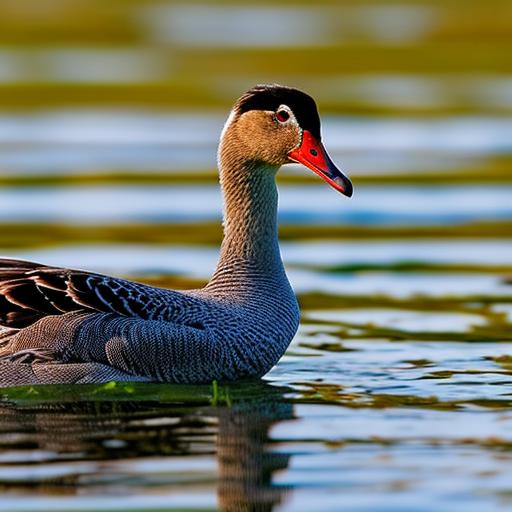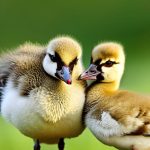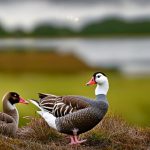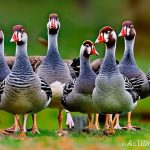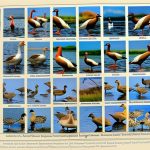Breeding behavior in geese is a fascinating and complex topic that plays a crucial role in the survival and reproduction of these birds. Geese are known for their strong pair bonds and elaborate courtship displays, which are essential for mate selection. Understanding the breeding behavior of geese is important not only for scientific research but also for conservation efforts and the management of these populations.
Key Takeaways
- Geese have complex breeding behaviors that involve mating rituals, courtship displays, nesting habits, incubation, and parental care.
- Successful reproduction in geese is influenced by factors such as genetic diversity, environmental conditions, and predator avoidance.
- Breeding season and timing vary among different species of geese, with some breeding in the spring and others in the fall.
- Breeding geese in captivity presents challenges such as maintaining genetic diversity and providing appropriate nesting and feeding conditions.
- Understanding the breeding behavior of geese is important for conservation efforts and for managing their impact on agricultural systems.
Mating Rituals and Courtship Displays of Geese
Mating rituals and courtship displays are an integral part of the breeding behavior of geese. These behaviors serve several purposes, including attracting a mate, establishing pair bonds, and ensuring reproductive success. During courtship, male geese often engage in elaborate displays such as head bobbing, wing flapping, and honking. These displays not only demonstrate the male’s physical fitness but also serve as a form of communication to attract females.
The importance of these behaviors in mate selection cannot be overstated. Female geese are known to be selective when choosing a mate, and they often evaluate males based on their displays and physical condition. The more elaborate and vigorous the display, the more likely a male is to attract a mate. This ensures that only the fittest males are able to reproduce, leading to stronger offspring and increased chances of survival.
Nesting Habits and Preferences of Geese
Geese have specific nesting habits and preferences that are crucial for successful reproduction. They typically choose nesting sites near water bodies such as lakes, ponds, or rivers. The female goose constructs the nest using grasses, twigs, and feathers, creating a comfortable and secure environment for her eggs.
Choosing the right nesting site is of utmost importance for geese. They prefer areas that provide good visibility to detect potential predators and have easy access to food sources. The proximity to water is also essential for the safety of the nest and the survival of the eggs. Nesting in areas with dense vegetation or tall grasses can provide additional protection from predators.
Incubation and Hatching of Goose Eggs
After the female goose has laid her eggs, she begins the process of incubation. Incubation typically lasts around 25 to 30 days, during which the female remains on the nest to keep the eggs warm and ensure their proper development. The male goose often stands guard nearby, protecting the nest from potential threats.
Proper incubation and hatching conditions are crucial for the survival of goose eggs. The female goose carefully regulates the temperature and humidity of the nest, ensuring optimal conditions for embryo development. Any disturbance or interruption during this period can have detrimental effects on the eggs, leading to reduced hatching success.
Parental Care and Protection of Goslings
Once the eggs have hatched, both parents play an active role in caring for and protecting their goslings. The parents guide their young to food sources, teach them how to swim, and protect them from predators. Goslings stay close to their parents for several weeks, learning important survival skills and gradually gaining independence.
Parental care is vital for the survival of goslings. The parents provide warmth, protection, and guidance, ensuring that their offspring have the best chances of survival. Without proper parental care, goslings may struggle to find food, evade predators, or navigate their environment effectively.
Factors Affecting Reproductive Success in Geese
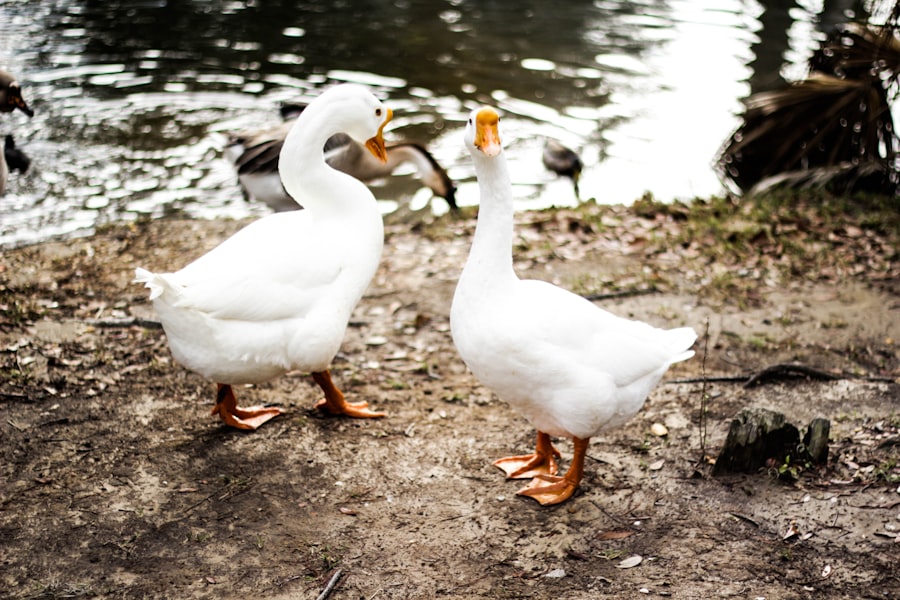
Several factors can influence the reproductive success of geese. Habitat loss and degradation can reduce suitable nesting sites and food availability, leading to decreased breeding success. Climate change can also impact breeding behavior by altering migration patterns and disrupting the timing of breeding seasons.
Predation is another significant factor affecting reproductive success in geese. Nest predation by mammals or other birds can result in the loss of eggs or goslings. Increased predation pressure can lead to reduced breeding success and population decline.
Understanding these factors is crucial for conservation efforts. By identifying and addressing the threats to reproductive success, conservationists can implement targeted strategies to protect and restore critical habitats, reduce predation risks, and mitigate the impacts of climate change.
Breeding Season and Timing of Geese
Geese have specific breeding seasons and timing that are influenced by various factors, including environmental conditions and resource availability. Breeding seasons typically occur in the spring or summer when food sources are abundant, and weather conditions are favorable.
The timing of breeding is crucial for successful reproduction. If geese breed too early or too late in the season, they may face challenges such as food scarcity or unfavorable weather conditions. Breeding at the right time ensures that goslings have access to sufficient food resources and favorable environmental conditions for growth and development.
Geese Breeding in Captivity: Challenges and Opportunities
Breeding geese in captivity presents both challenges and opportunities. Captive breeding programs can play a vital role in conserving endangered or threatened goose populations by increasing their numbers and genetic diversity. However, breeding geese in captivity requires careful management to ensure the health and well-being of the birds.
One of the main challenges in captive breeding is maintaining natural behaviors and preventing domestication. Geese bred in captivity may lose their wild instincts, making them less suitable for reintroduction into the wild. Additionally, ensuring genetic diversity is crucial to avoid inbreeding depression and maintain healthy populations.
Genetic Diversity and Conservation of Goose Populations
Genetic diversity is essential for the long-term survival of goose populations. It allows for adaptation to changing environmental conditions, increases resistance to diseases, and improves overall fitness. Maintaining genetic diversity requires preserving natural habitats, preventing habitat fragmentation, and implementing strategies to reduce genetic isolation.
Conservation efforts should focus on protecting critical habitats, restoring degraded areas, and promoting connectivity between populations. Genetic monitoring and management can help identify populations at risk of inbreeding and implement strategies to maintain genetic diversity.
Implications of Breeding Behavior for Ecological and Agricultural Systems
The breeding behavior of geese has implications for both ecological and agricultural systems. Geese play a crucial role in ecosystem functioning by dispersing seeds, controlling vegetation growth, and providing food for predators. Understanding their breeding behavior can help manage their populations effectively and maintain a healthy balance in ecosystems.
In agricultural systems, geese can cause damage to crops and grazing areas. Understanding their breeding behavior can help farmers implement effective deterrent strategies or develop sustainable management practices that minimize conflicts between geese and agricultural activities.
Understanding the breeding behavior of geese is essential for conservation efforts, scientific research, and the sustainable management of these populations. Mating rituals, nesting habits, incubation, parental care, and timing of breeding all play crucial roles in the survival and reproduction of geese. By studying and protecting these behaviors, we can ensure the long-term survival of these magnificent birds and the ecosystems they inhabit.
If you’re interested in breeding geese and want to ensure the best care for your goslings, you may find this article on “How to Care for Goslings” from Poultry Wizard quite helpful. It provides valuable insights and tips on raising healthy and happy goslings, covering topics such as feeding, housing, and general care. Whether you’re a beginner or an experienced breeder, this article will surely enhance your knowledge and help you create a nurturing environment for your geese. Check it out here.
FAQs
What is breeding behavior in geese?
Breeding behavior in geese refers to the actions and activities that geese engage in during the mating season in order to reproduce.
When do geese typically breed?
Geese typically breed in the spring, between the months of March and May.
What are some common breeding behaviors exhibited by geese?
Common breeding behaviors exhibited by geese include courtship displays, nest building, egg laying, incubation, and caring for young goslings.
How do geese choose a mate?
Geese typically choose a mate based on physical characteristics such as size, coloration, and overall health. They may also engage in courtship displays to attract a mate.
How many eggs do geese typically lay?
Geese typically lay between 4 and 8 eggs per clutch, although some species may lay more or less.
How long does it take for goose eggs to hatch?
Goose eggs typically take between 28 and 32 days to hatch, depending on the species.
Do male and female geese share parenting responsibilities?
Yes, male and female geese typically share parenting responsibilities, with both parents taking turns incubating the eggs and caring for the young goslings.
Meet Walter, the feathered-friend fanatic of Florida! Nestled in the sunshine state, Walter struts through life with his feathered companions, clucking his way to happiness. With a coop that’s fancier than a five-star hotel, he’s the Don Juan of the chicken world. When he’s not teaching his hens to do the cha-cha, you’ll find him in a heated debate with his prized rooster, Sir Clucks-a-Lot. Walter’s poultry passion is no yolk; he’s the sunny-side-up guy you never knew you needed in your flock of friends!

